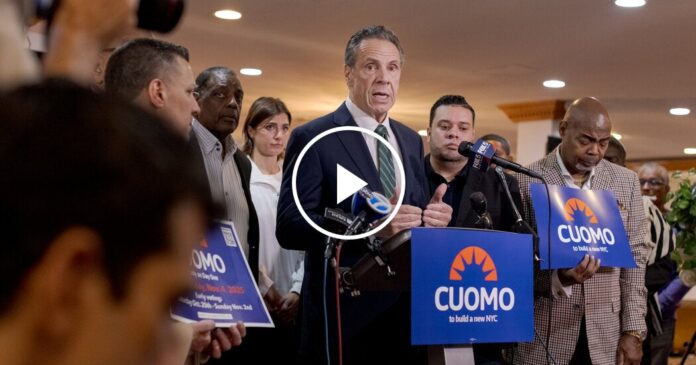“Can you describe rent prices in New York?” “High.” “Expensive.” ”Out of control.” ”The rent here is absolutely crazy.” “Very, very unaffordable. Two verys — yeah very, very expensive.” Median asking rent in New York City is up more than 7 percent in just the last year. It’s now about $4,000 per month. That’s made the cost of housing a key issue in the mayor’s race, with the top candidates each proposing changes to a core New York City housing policy: rent stabilization. Nearly half of the apartments in New York are currently rent stabilized, which means that their rent increases are determined by a government agency controlled by the mayor. That makes rent stabilization a hot button issue for hundreds of thousands of voters. After front-runner Zohran Mamdani revealed what he pays in rent — “$2,300 for my one bedroom in Astoria.” — rival Andrew Cuomo argued he was unfairly occupying an affordable apartment and shouldn’t qualify for rent stabilization because he makes $142,000 a year. “Rent-stabilized units, when they’re vacant, should only be rented to people who need affordable housing.” Many rent-stabilized tenants are low income, but about 16 percent of rent-stabilized households do earn at least $150,000 a year. If elected mayor, Cuomo says you could only qualify for a rent-stabilized apartment if your rent is 30 percent or more of your income. Let’s say this couple is looking for an apartment. Their salaries are $35,000 and $45,000 a year. They find a rent-stabilized apartment for $2,000 a month. That’s 30 percent of their income. So under Cuomo’s plan, this couple will face less competition for this lease because anyone who makes more than them could not apply for the the apartment. Means-testing is popular with voters. About 65 percent supported it in a recent Times-Siena poll. But critics argue that Cuomo’s plan reflects a misconception that rent stabilization is an affordable housing program. In fact, it’s a form of market regulation with roots in the postwar era. “After World War II, you had returning G.I.s starting families.” The rent gets too damn high and the government takes a look to say, ‘Is there something we could do about it?’” Some apartments in this period were rent-controlled. The system that eventually effectively froze 1970s rents in place like the famously low-rent apartments from “Friends” and “Sex in the City.” “You have a rent-controlled apartment? I suggest you stay there.” In reality, only about 1 percent of apartments are rent controlled today. Most are now covered by rent stabilization, which first became law in 1969. “It really was this broad-based sense that tenants needed the government to come in and kind of limit that increase in their rent. Rent stabilization was not designed to take into account the income of the tenant at all. Rent regulation was really put into place to say when the vacancy rate is so low, landlords can’t use that as an opportunity to gouge tenants for increases in rents.” Today, rent stabilization applies to most apartments in buildings with at least six units that were built before 1974. That covers about one million units and two million New Yorkers. Rent increases are set by the mayor-appointed Rent Guidelines Board. “So you’re not at the mercy of your landlord solely. They can only go according to the increased percentage rate that the Rent Guidelines Board decides.” Joanne Grell is a tenant advocate in the Bronx. She moved into a rent-stabilized apartment nearly 25 years ago and still lives in it today. “I moved here back in 2002 with a 2-year-old and a 5-year-old, not knowing exactly how I was going to be able to be a single mom and afford to live in the city. Fast forward 23 years later, I raised my children here.” When she moved in, her rent was about $950 a month. She earned a moderate income, but if means-testing had been in place, she wouldn’t have qualified for her unit. “When I moved in here 23 years ago, it might have been 20 percent of my salary. So if Cuomo’s means-testing proposal was in place when I applied for this apartment, I would have never been able to get it.” Now, she does spend more than 30 percent of her income on rent, which has gone up to $1,750 a month. Grell plans to vote for Mamdani this election because she believes his proposal to freeze the rent would help struggling tenants like her and 69 percent of voters in the Times-Siena poll agreed. “My upstairs neighbor said to me, ‘If I get another increase, I will not be able to keep my apartment.’ That’s how serious it is.” David Reiss said that Mamdani’s rent freeze would help tenants in the short term, while Cuomo’s means-testing would be an administrative nightmare that could make life difficult for many. Ultimately though, he said neither of these policies address the root cause of high prices: that there aren’t enough apartments to go around. Both mayoral candidates have said they support building hundreds of thousands of units to help address the housing shortage. “We need more housing, a lot more.” “Get the supply up. The rents will come down.” But Reiss says neither candidate’s plans would meet the demand and don’t account for factors like population growth or apartments being demolished. “Politicians from President Trump to Andrew Cuomo to Zohran Mamdani, have all proposed policies to address housing affordability. But it can’t just be doing what we’re doing now, but a little bit better. Fundamentally, if you want to increase affordability, you have to build more housing.”
Rent Control,Andrew Cuomo,Affordable housing,Real Estate, Housing,Mayoral races,Rent Guidelines Board,Zohran Mamdani,NYC;New York City
#Whats #Andrew #Cuomos #Plan #York #City #Renters

